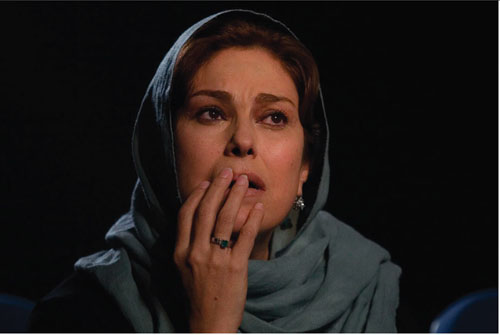The ultimate success of Shirin, as Sweeney rightly notes, is in the director's elaboration of off-camera space, which it bears noting has been long central to the filmmaker's formal strategies. In Shirin, Kiarostami shoots over one-hundred separate women, all framed in close-up while wearing headscarves, in a darkened movie theatre. Subsequent to a title sequence in which the director introduces us (through pages of an illuminated manuscript) to the subject of the screened film, the epic poem "Khosrow and Shirin," Kiarostami fixes on his human subjects for the full duration of the projected film's un-spooling; that is, the filmmaker never once reverses field to the picture that his female spectators (along with the small number of male viewers visible likewise over their shoulders) watch. As Kiarostami's camera trains motionlessly on their faces, we hear music, voices and ambient sounds all emanating from the off-camera screen. Thus, the filmmaker not only establishes the presence of the visually absent screen, but intimates further, through the competing panoply of the aforesaid sounds, a space that is itself the combination of both on and off-camera fields - a spatial mise en abyme.
In suggesting an off-screen, on a screen that is itself off-screen, Kiarostami further expands the space depicted in his cinema, which as always far exceeds that which the director captures with his camera. Again, as always, Kiarostami constructs the space of his film to insist on its relative minimality in contrast to the non-visible world beyond the edges of the frame, where he articulates a world unseen through characters who fail to appear on camera (as in The Wind Will Carry Us, 1999) or, as in Shirin, by a film-within-the-film that never appears on film. It is a reality forever consigned to invisibility by dint of its lack of visual materiality, save for its instantiating audio track. And for the light that implicitly dances off the screen, on to his female figures' faces, modulating the space with the changes in tone that appear on the non-existent screen.
Importantly, Shirin's off-screen film-within-the-film reads as both strongly narrative and heavily dramatic - two properties that Kiarostami's unbroken series of spectatorial close-ups lacks entirely; "Khosrow and Shirin" is a film that the director would never make - at least in the conventional form that it seems to maintain. Then there is, once again, that which Kiarostami does shoot, the hundred-plus female faces that his narrative alternates between as they watch a fictional film (with the incumbent gaps between the off-screen film's narrative and the reactions they generate essentially ex nihilo; there is thus an artificiality to the experience presented by the feature, which Juliette Binoche's sudden appearance further confers). Indeed, in choosing intimate framings of (almost exclusively) strikingly beautiful women of a variety of ages, Kiarostami undermines the logic of the mandatory coverings that all of the women wear, namely to reduce focus on the physical attributes of women. Just as Shirin is a film about invisible cinematic space, absent presence, it is also a work about women, about making their interiority visual through the act of performance, and of its calculation to bring mentation to the face's surface - even as Kiarostami rehearsed his actresses to emote less. Ultimately, in its feminine focus, Kiarostami's latest continues the more political emphasis of the director's superior Ten (2002), while reaffirming that the baseline of minimalist modernist cinema today rests in close-ups of the human face - see the director's Taste of Cherry (1997) and Ten, Pedro Costa's Colossal Youth (2006) and Wang Bing's Fengming: A Chinese Memoir (2007).
Indeed, It's Winter's narrative elisions and visual evasions serve to allegorize life in a nation where so much remains hidden from view (a strategy that is equally evident in Shirin's compendium of head-scarfed female spectators). However, unlike the visual minimalism of Kiarostami's latest, though very much in the spirit of the director's previous Through the Olive Trees, The Wind Will Carry Us and Five, Pitts's work is landscape dependent, expressing meaning through the locational, seasonal and temporal specificity of its visually rich exteriors - as for instance in a lyrical, early frame in which the first husband walks down a deserted highway in the eponymous season, or in the heavy snowfall that descends upon the village's railroad tracks, which Pitts composes in a diagonal long. This is a work where the absences are primarily narrative rather visual.

4 comments:
An excellent treatment as usual, Michael. I agree with your sentiments regarding Koker. Have you written about Five specifically yet? I would love to see you expand a bit more on that one as, for me, it is a tremendously rich experience but one that makes such different demands to K's other work (functioning even more closely to his photographic studies) as to require an almost willful cognitive shift to appreciate it. Course I have yet to see Roads of Kiarostami so I'm not certain how he develops this strain in later work.
Rafi Pitts' IT'S WINTER was released on DVD in the U.K. by Artificial-Eye, not MoC.
And the film is also available in the U.S., courtesy of Facets.
Arsaib, forgive me, I was very sloppy; thanks for the correction. (Of course I had a copy of the Artificial-Eye disc and wrote Masters of Cinema, with my mind it seems being elsewhere.) Also, thank you for noting that Facets has followed suit. That's good news for US viewers.
Nathaniel, thank you as always. I have not written on Five to date; I agree that it would be a fine subject for further analysis. And of course you are absolutely right to say that it makes different demands than his other works of the cinema; how exactly I would frame this difference, however, I cannot say at this point.
Hey Mike, I still haven't seen THROUGH THE OLIVE TREES, much to my eternal dismay, so I may have to revise my "most moving" statement down the road.
Post a Comment